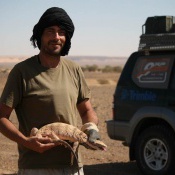Modelling terrestrial biodiversity in the Cape Verde Islands: combining ecogeographical information with molecular markers
The Cape Verde are an archipelago of 10 islands located in the Atlantic Ocean between 16•N and 24•W, about 600km from the African coast. They form part of one of the worlds "biodiversity hotspots” (Myers et al. 2000). Although 60% of mammals and 25% of reptiles are considered threatened species, a low percentage of the land area (0.3% of 4033km2) is classified as a protected area.
The primary aim of this project is to assess genetic variation within several groups of species, including vertebrates, and use this combined information with modelling techniques to determine terrestrial biodiversity conservation status. By extensive prospecting of islands of different sizes, habitats, and ages, by examining mtDNA and nuclear sequences and relating diversity patterns with ecogeographical variables, it is expected to understand the distribution patterns of endemic species. The collated data will provide inferences of speciation within islands and contribute to the identification of hotspots of endemisms to enable the establishment of appropriate local conservation areas.
Octavio Fernando Sousa Salgueiro G Paulo, Maria Salome Soares Pais, José Manuel Abreu de Jesus, Maria Manuel Cordeiro Salgueiro Romeiras




